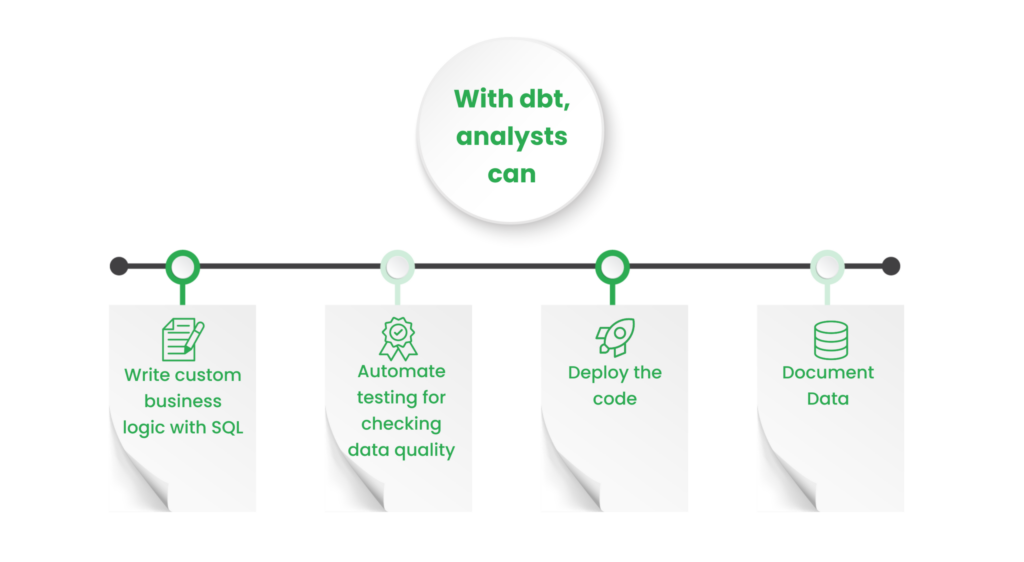When most companies think about data workflows, it often starts with an immediate problem: the need for better insights, faster reporting, or more reliable numbers to fuel business decisions. Typically, the first instinct is to throw more people and more tools at the problem. Yet, as we scale, something becomes painfully clear—managing data without structure leads to more complexity, not less. This is where dbt comes in, but before we dive into the tool, let’s take a step back and think about why it’s needed in the first place.
The Growing Complexity of Data Management
As businesses grow, so does their data. What starts as a small team managing spreadsheets or ad-hoc SQL queries quickly spirals into a vast network of data pipelines, fragmented logic, and multiple teams managing inconsistent processes. Soon, the very thing that should help decision-making—data—becomes a source of confusion.
How many times have we seen teams spend days cleaning up messy SQL scripts, or worse, duplicating efforts because one hand doesn’t know what the other is doing? The inconsistency isn’t just frustrating; it leads to decisions being made based on inaccurate or incomplete information. At some point, this approach hits a wall.
This is where dbt (data build tool) starts to make sense, but it’s not about the tool itself—it’s about the shift in how we think about data.
Moving from Chaos to Clarity
Let’s imagine a scenario where your company’s data is scattered across various silos, and no one truly understands how it’s being transformed along the way. Each department operates with their own logic, and when you try to trace the lineage of a key metric, it’s like untangling a ball of yarn. This is the chaotic state many organizations find themselves in before adopting dbt.
What dbt offers isn’t a magic solution, but a structured mindset that empowers data teams to build transformation logic in a way that’s scalable, consistent, and transparent.
Think of dbt as turning that ball of yarn into a neatly organized thread—everything is traceable, documented, and version-controlled. What once took hours or days to understand can now be explained in minutes.

The Thought Process Behind dbt
At its core, dbt operates on a simple principle: treat data like software. This means applying best practices from software development—version control, testing, modularity—to data workflows. It’s not a revolutionary idea, but it’s one that data teams have been slow to adopt. Why? Because historically, the T in ETL (transformation) has always been buried deep in the backend, handled by engineers with little visibility or collaboration from analysts.
dbt changes that by allowing analysts—those closest to the business logic—to own the transformation process. Suddenly, those ad-hoc SQL scripts evolve into tested, reusable models that the entire team can understand and trust.
Realizing the Power of Ownership
Here’s where the shift happens. When teams adopt dbt, they realize it’s not just about creating cleaner code; it’s about empowering analysts to take ownership of the entire transformation pipeline. Data is no longer something that’s tossed over the wall from one team to another. Instead, it becomes an integrated, collaborative process where everyone has visibility and accountability.
This shift in ownership not only accelerates development but also drastically reduces errors and confusion. When analysts write and test their own transformations, there’s less room for miscommunication. And because dbt enforces version control, every change is tracked, making it easier to manage updates and debug issues as they arise.

From Gatekeepers to Collaborators
One of the most important realizations with dbt is that it enables data teams to shift from gatekeepers to collaborators. In many organizations, data teams are viewed as bottlenecks, slowing down processes because they’re seen as the protectors of data integrity. While this role is critical, it often creates friction between business teams who need fast answers and data teams tasked with ensuring accuracy.
dbt bridges this divide by offering transparency and automation. Business users can see exactly how data is transformed and, because the process is automated and tested, they can trust the results without having to constantly ask the data team for clarification.
Why dbt Isn’t Just Another Tool
At this point, it’s easy to think dbt is just another tool in the ever-growing data ecosystem, but it’s more than that—it’s a mindset shift. dbt encourages teams to adopt processes that focus on scalability and reliability from the start, instead of patching things together down the road.
It also represents a departure from the traditional ETL process by focusing solely on transformation and doing it within the data warehouse itself. By leveraging the power of the data warehouse, dbt eliminates the need to move data around multiple systems, reducing complexity and speeding up the entire process.
A New Era of Data Management
dbt’s real power lies in its ability to bring order to chaos. It transforms how we think about managing data at scale and pushes teams to adopt practices that ensure consistency, transparency, and efficiency. No longer are data pipelines a black box hidden away from business users. With dbt, they become a shared, open process that drives better decision-making across the entire organization.
The question isn’t whether your team should use dbt; the question is why wouldn’t you want a solution that encourages collaboration, transparency, and ownership? In a world where data is increasingly the key to staying competitive, dbt offers a clear path forward.
